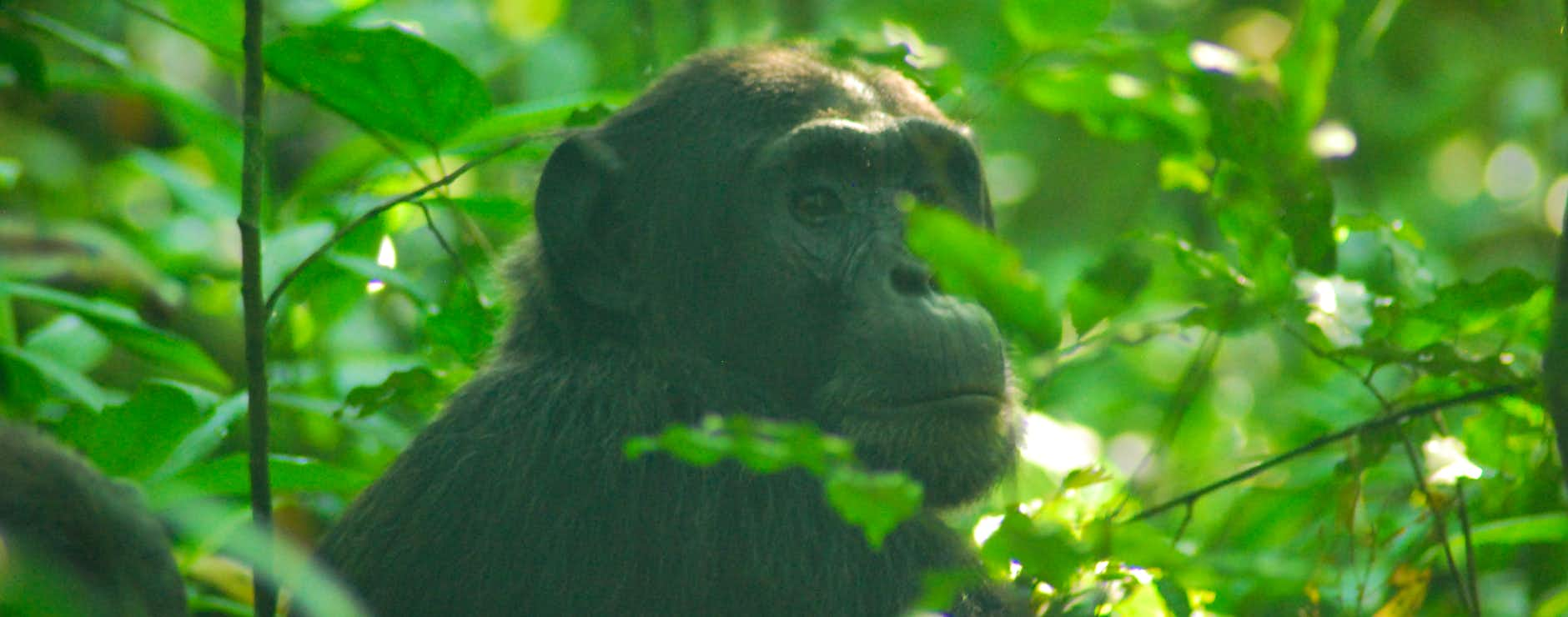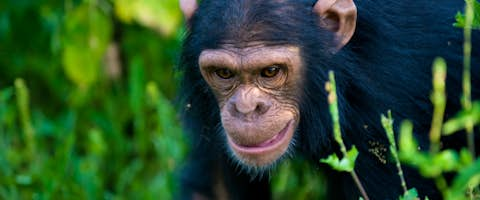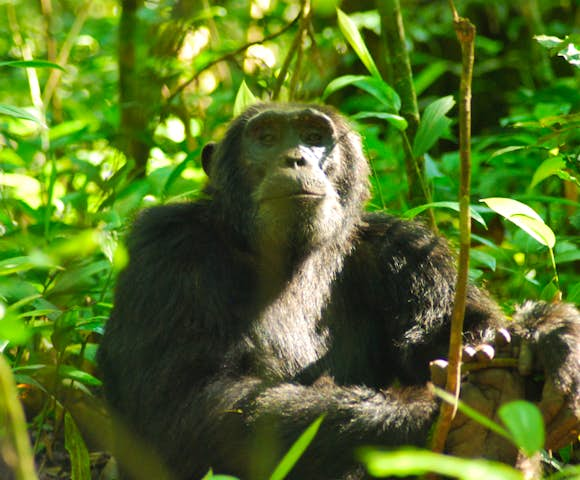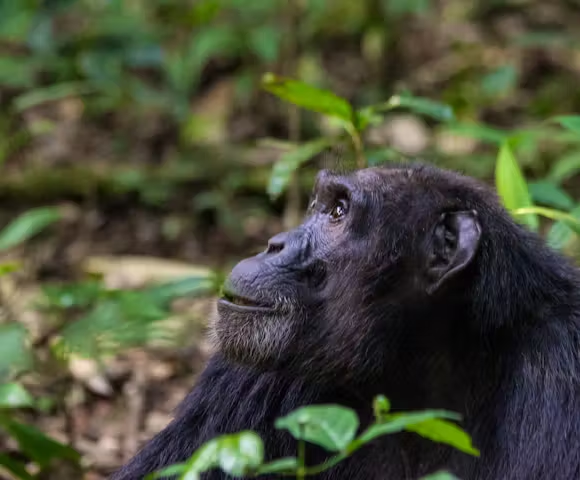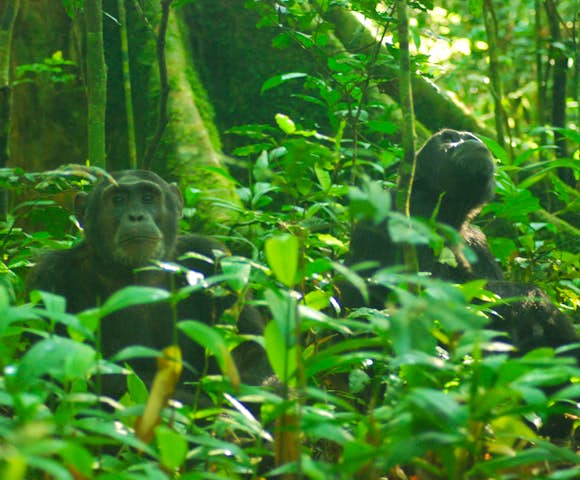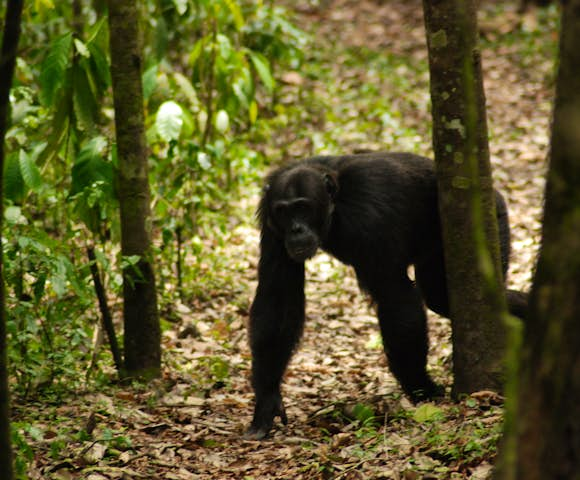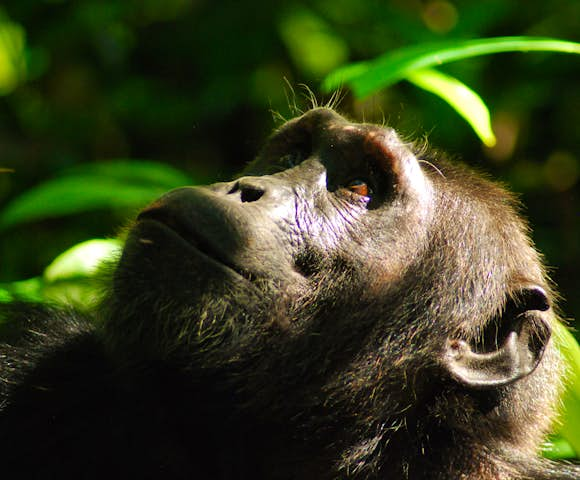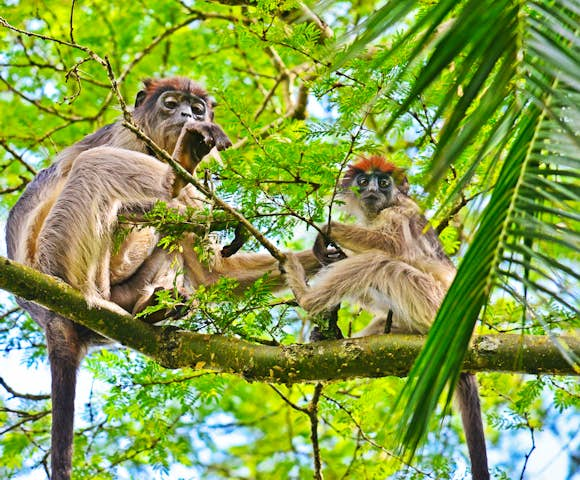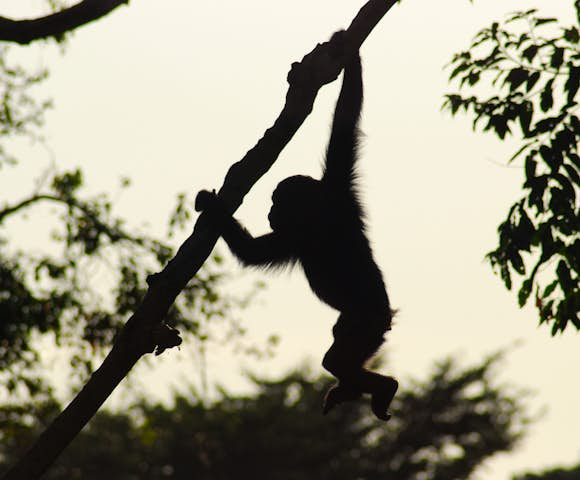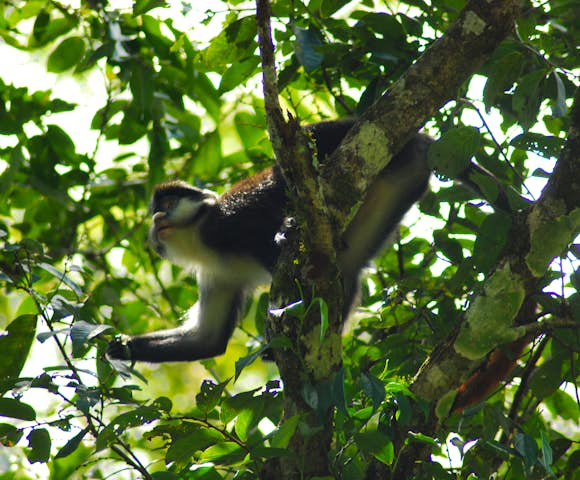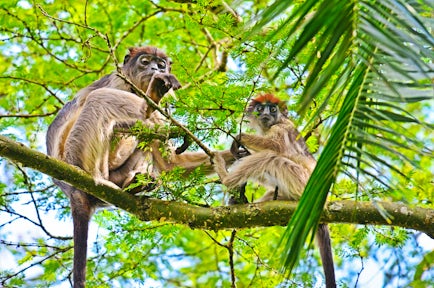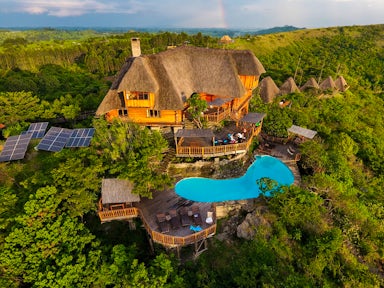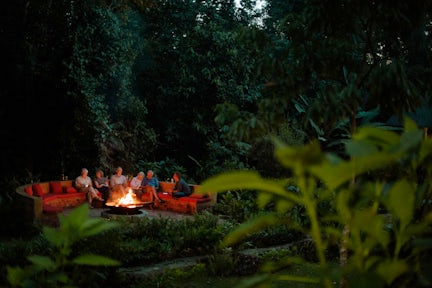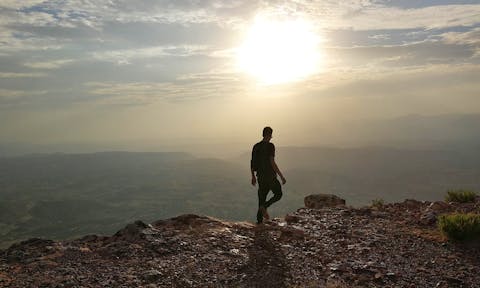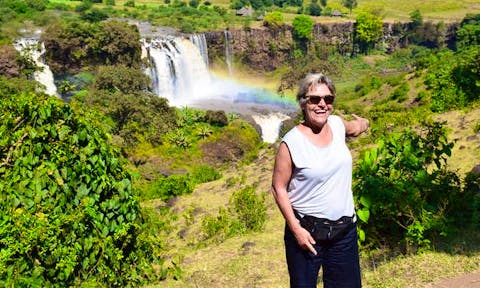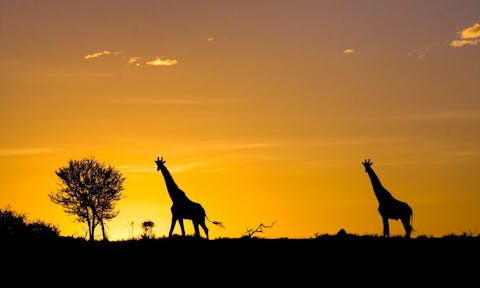Our most popular trips including Kibale Forest
The tours below showcase just some of what is possible. Use these itineraries as starting points, or to draw inspiration. Then get in touch, and let our expert team help craft the perfect itinerary for you.
Guide to Kibale Forest National Park
Contents of our guide
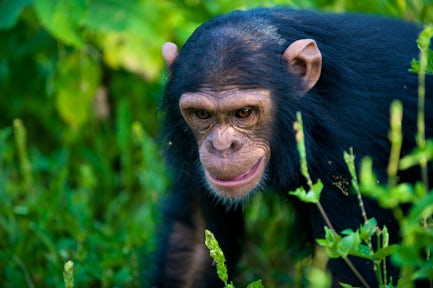
By no means a support act to the gorillas, Kibale Forest's chimps are beautiful.

Brilliant says
If you want a quieter chimp trek with fewer other trekkers around, opt to the afternoon session. The morning session is usually busier, as most people plan their trips with chimp trekking in the morning, and a trip to the Bigodi Wetlands in the afternoon. However, keep in mind that morning sessions are generally speaking slightly better for sightings.
1. Introduction to Kibale Forest
Why visit Kibale Forest?
The chimpanzees have made Kibale one of Uganda’s most famous wildlife destinations. You can join a small group and follow a Uganda Wildlife Authority Ranger into the forest on the trail of the chimpanzees, beginning to understand their environment as you walk. When contact is made, you stand quietly - slightly unbelieving - and have up to one hour to observe our closest relatives from a distance of just a few metres.
At Kibale, there's a strong urge to pull on your boots and walk. The forest, with its epiphyte-covered passes, tangled undergrowth and sun dazzled glades teeming with life, is a proper outdoor adventure. Sure, it is hot, the nettles are king-size, and you don’t want to mess with the ants, but every step taken is a discovery.

Sit with the chimps on their turf.
2. Chimpanzee Trekking in Kibale Forest
Classic chimpanzee treks
The main draw of Kibale is the chimpanzees. Chimpanzee trekking is much easier than gorilla trekking, and you can also join the habituation team to spend hours with these amazing animals.
The high number of chimpanzees, the accessibility of the forest and the length of habituation makes Kibale the most popular places to track chimpanzees in Uganda. Although sightings are not guaranteed, you have over a 90% chance of seeing them in Kibale.
Unlike gorilla trekking, Kibale’s terrain is not too challenging and so you don’t have to be particularly fit or able to trek for long periods to track chimpanzees. Standard tracking excursions last about three hours and include a maximum of one hour with the chimps, during which you can expect to get within 8-10 metres.
Permits are required to track the chimpanzees, and you will join a group (maximum of 8) led by Uganda Wildlife Authority Interpretive Rangers who will introduce you to the chimps and their forest world.
The tracking excursions depart twice a day at 08:00 and 14:00. The morning departures are the busiest because many itineraries combine it with an afternoon visit to the Bigodi Wetland Sanctuary.
Chimpanzee Habituation
For photographers or those with an interest greater than can be satisfied by just one hour, you can join the researchers of the habituation team to spend either a half-day or a full-day in the forest, far from the busier paths.
Walking with the habituation research team, you will push deeper into the forest. These chimps are less used to human presence and so the experience is unpredictable and can be challenging if the chimps decides to move quickly to another location.
This experience is available as both a half and full day excursion. For those joining for the full day, you will join the chimps from when they break nests at about 6:30am and stay with them the whole day until they nest again for the night at about 7pm.
3. When to Visit the Kibale Forest
To a certain extent, a tropical forest generates its own weather patterns. That, plus Uganda’s equatorial position, means that you should always be prepared for some rain during your stay.
That said, it is generally still true that the wetter months are April and May, and November. The hottest months are January and December.
The whole concept of 'best time to visit' doesn't really apply to Uganda. The country is equatorial and so receives similar temperatures throughout the year and rainfall can be expected year-round. Weather patterns are also changing, meaning rigid seasonality is becoming outdated.
A typical 3 day safari in Kibale Forest
-
Day 1
The first day is typically a travel day. Depending on where you are coming from, you will either drive through beautiful landscapes towards Kibale Forest, or if you are coming from Entebbe, you will catch an internal flight to Kasese airstrip before beginning the drive. After stopping for lunch at a local restaurant, time permitting you will explore the crater lakes and continue on to the park.
Primate Lodge or Kyaninga Lodge are the most popular accommodation option
-
Day 2
After an early breakfast, make your way to the nearby park HQ for the pre-tracking briefing, after which you will walk or drive to the trailhead for the start of an unforgettable adventure – hiking in the footsteps of the habituated family of chimpanzees.
En-route, your guide will share stories and facts about the forest and its other inhabitants including other species of primates and birds and other big mammals. Once contact is made, you will spend an unforgettable one hour with them as they go about their daily life - feeding, playing, grooming, taking care of their young, howling and screeching, in their natural habitat. Return to the lodge for lunch then in the afternoon enjoy a guided nature walk through the Bigodi wetland.
Bigodi Swamp Walk is an initiative of the local community and is known for its rich diversity of birds and primates. The path and boardwalk may be flooded and muddy after heavy rainfall and gumboots are recommended. The walk is about 4km in length taking 3-4 hours at birding pace with local community guides. All proceeds from eco- tourism go back to into the community, a conservation project well worth supporting.
-
Day 3
Spend the day exploring the pock-marked landscape of the crater lakes region, spend the afternoon at leisure or visiting a local community. You can decide during your trip and your guide will make the necessary arrangements.
As your time in Kibale draws to a close, continue your onward journey in this incredible country.
5. Beyond the Chimpanzees
Bigodi Community Wetland Sanctuary
Bigodi is prime birding and monkey habitat, but a walk here is also a wonderful way to support a superb community tourism initiative. The sanctuary is run by the Kibale Association for Rural and Environmental Development and all profits support education and income-generating initiatives in the Bigodi Cultural Centre. Guided walks last for about three hours and depart in the morning and afternoon. Birders are recommended to join the morning walks to enjoy Bigodi at its best.
While you may not see great numbers of species, those you do will be very special because they are forest-fringe and swamp dwellers, plus West African species at the eastern limit of their range. The impressive great blue turaco is often seen. Other highlights include the papyrus gonolek; grey-throated, yellow-billed, yellow-spotted and double-toothed barbets; speckled, yellow-rumped and yellow-throated tinker barbets; yellow-bill; and black-and-white casqued hornbill.
The canopy is shared with a great range of monkeys. Red colobus are commonly seen, as are red-tailed monkeys, L’Hoest’s monkey, black-and-white colobus and grey-cheeked mangabey. If you are particularly lucky, you may see chimpanzees foraging on the swamp edges, disturbing the elusive sitatunga antelope.
Toro Crater Lakes Exploration
The crater lakes are a glorious scenic contrast to the forests and swamps of Kibale and can be accessed from all properties. Explore them as part of a day drive with your guide or from crater-rim lodges.
More than 30 permanent crater lakes exist in the Toro region, scattered over 10 kilometres on the western boundary of the park. It is a heavily cultivated area (the climate is ideal), but lush pockets of forest remain. The lakes are a mixture of saline and freshwater and some are bilharzia-free, making for a spectacular wild swimming spot.
The lodges in this area, like Kyaninga and Ndali, offer canoeing, mountain-biking and walking trails for a more active experience of a beautiful place.
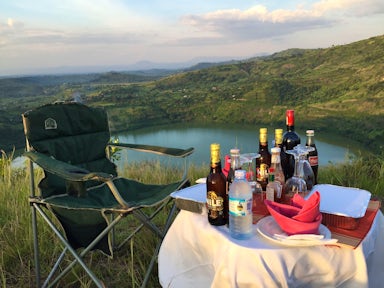
6. Accommodation Options
Kyaninga Lodge
About an hour from the forest, the small, bustling, town of Fort Portal offers a great place to stay if you want to explore the foothills of the northern Rwenzori Mountains and the Semliki Valley as well as Kibale Forest.
Kyaninga Lodge is an unforgettable story as well as an amazing place to stay. Luxury cabins constructed from massive eucalyptus logs, built by self-taught builders, line the rim of the Kyaninga Crater looking down into the 220-metre lake below.
Think an alps ski chalet meets jungle lodging, and you have Kyaninga Lodge.
Primate Lodge
Of course, many visitors don’t want to just visit the forest, they want to stay there; experiencing the transition between night and day, becoming enveloped in the endless sounds of birdsong, insects, and animals pushing through the undergrowth and the heavy drops of tropical rain.
If this is you, then Primate Lodge is the place to stay. Located just a 5-minute walk from where the chimp treks begin, Primate is a very comfortable lodge in the heart of the forest. Each thatched cottage looks out into its own area of forest, while the open dining area and sitting room looks out onto a forest full of butterflies when the sun shines.
Ndali Lodge
One of the most popular options in the Toro Crater Lakes area is Ndali Lodge in the Rwaihamba Cluster. Owner-managed and set on a tea-estate established by the same family in the 1920s, the lodge has a quirky, English-country house feel with beautiful views to the west and the peaks of the Rwenzori Mountains.
Small scale, locally-owned lodges like these are so special. The owner of Ndali goes above and beyond to ensure you enjoy your stay, the food is always excellent and the views simply staggering. Simple, unassuming, and always over-delivers.
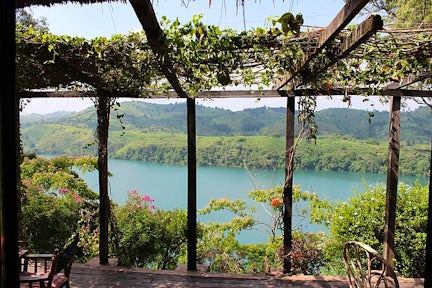
7. Getting there
Kibale is a six-hour drive on generally good roads from Entebbe. The drive from Murchison Falls National Park south down the Escarpment to Kibale takes about seven hours. The ongoing journey from Kibale to Queen Elizabeth National Park takes about three hours.
Alternatively, scheduled light aircraft flights operate between Entebbe and the town of Kasese. The transfer from Kasese to Kigali takes just under two hours. Flights also link Kasese to Murchison in the north and Kihihi and Kisori, the entry points for Bwindi Impenetrable Forest in the south.

Uganda is home to around 5,000 chimpanzees and 1,500 live in Kibale Forest.
8. Flora & Fauna
Fauna
Chimpanzees
1,450. That’s the number of chimpanzees thought to inhabit Kibale Forest, sharing 795 kilometres squared of protected habitat with a total of 13 primate species including the threatened red colobus monkey and the rare L’Hoest’s monkey.
The habitats of Kibale make it the best place to see primates in Africa.
Elephants, leopards, and more
There are 70 mammals in the park. The largest of these is the elephant, of which 500 are thought to inhabit the shadows, alongside buffalo, leopard, warthog, bush pigs, golden cats and duikers. The elephants are of the forest race, smaller and hairier than their savannah cousins.
Bird life
Raising your eyes into the canopy and beyond brings you to the birds. Kibale has 375 recorded species including the Red-winged Francolin, Green-breasted Pitta, Joyful Greenbul, White-bellied Crested Flycatcher, Woodland Warbler and Orange-tufted Sunbird. Four species: Nahan’s francolin, Cassin’s spinetail, blue-headed bee-eater and masked apalis are not recorded in any other national park. Bigodi Wetland Sanctuary and the stretch of forest bordering both sides of the road to the Kanyanchu Tourist Centre are normally the most productive birding spots.

Flora
Protected, initially since the 1930s as a logging reserve, and as a national park since 1993, the forest has over 351 tree species, the oldest and tallest specimens reaching 200 years and 55 metres.
75% of Kibale’s vegetation is forest with grassland savannah appearing on summits and ridges. The topography determines the nature of the forest, with swampy areas in valley bottoms and drier variation on the slopes.

Chimpanzees live within distinct social structures.
9. Geography & Geology of Kibale
For the geology buffs among you
Kibale Forest lies in Kabarole District on the eastern flanks of the Rwenzori Mountains about 50 kilometres north of the equator.
Kibale Forest Wildlife Corridor Game Reserve, a 180 km wildlife corridor that runs from Ishasha in the South of Queen Elizabeth National Park to Sebitoli, the northern region of Kibale Forest allows wildlife to travel freely between the two parks.
Kibale Forest has an elevation of 1,110m to 1,590m. Nearby is the eastern border of the rift volcanic belt with its series of volcanic vents. It is the ash expelled by explosions from these vents, scattered first by the passing of the inter-tropical convergance zone and then by gravity wind flow from the expanded ice-fields of the Rwenzori Massif during recent ice ages, that is responsible for the fertile soils of the forest.
The soils lie atop a basement complex of Precambrian gneiss projecting southward through the northern limit of the Ndale volcanic field.

Get up close and personal with the chimps on a habituation experience.
10. Popular Trips including Kibale Forest
The tours below showcase just some of what is possible. Use these itineraries as starting points, or to draw inspiration. Then get in touch, and let our expert team help craft the perfect itinerary for you.
Ready to explore Uganda?
Listen
We'll spend some time listening to your aspirations, then discuss the kind of experience that might suit you.
Match
Next we'll discuss the options, shortlist the best trips for you and present you our impartial recommendations.
Reserve
We'll place a 24 hour hold on your preferred option - without obligation - whilst we talk through the details.
Whatever your budget, group size, length of stay, preferred activity or appetite for adventure, we can help.
+1 315 645 2889

